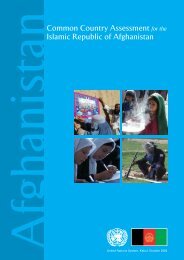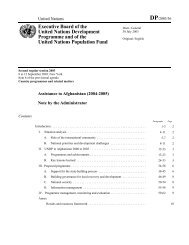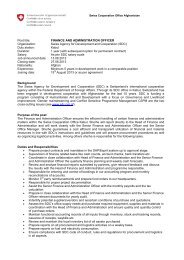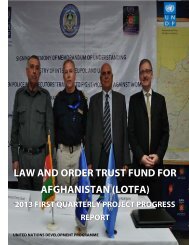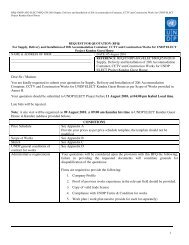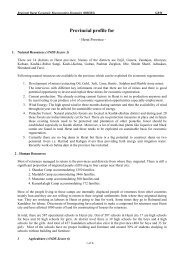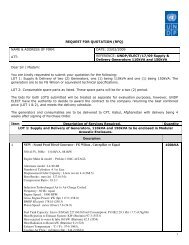(DIAG) Annual Project Report 2010 - UNDP Afghanistan
(DIAG) Annual Project Report 2010 - UNDP Afghanistan
(DIAG) Annual Project Report 2010 - UNDP Afghanistan
Create successful ePaper yourself
Turn your PDF publications into a flip-book with our unique Google optimized e-Paper software.
Disbandment of Illegal Armed Groups (<strong>DIAG</strong>)<br />
<strong>Project</strong> ID 00043604<br />
20<br />
the projects undertaken by implementing partners (construction companies etc.) showed<br />
evidence of low quality inputs, consequently reducing the value of the project. Monthly<br />
regional coordination meetings between MRRD and <strong>DIAG</strong>, and joint monitoring and<br />
evaluation missions aimed at resolving these issues at the earliest stages have been<br />
initiated. Although these issues have been mitigated through these actions, they continue<br />
to impact the final output.<br />
Further, the gap between <strong>DIAG</strong> district compliance and the delivery of the MRRD-led <strong>DIAG</strong><br />
Development <strong>Project</strong>s is a challenge for <strong>DIAG</strong> as the period of time required for the<br />
completion of MRRD projects is relatively long, with most of them taking over one year to<br />
complete. The strategy of using DSPs to bridge this time-gap was developed in 2009, and<br />
has been followed and executed successfully in <strong>2010</strong>, wherein nine DSPs were completed.<br />
V. Lessons Learned<br />
Development<br />
As <strong>DIAG</strong> focus turned to target districts with an AGE presence and also as a result of the<br />
DSPs that were completed in <strong>2010</strong>, a number of valuable lessons were learned during the<br />
course of the year.<br />
DSPs are viewed very positively in the communities where they have been undertaken, and<br />
have proven to be a valuable bridge between <strong>DIAG</strong> compliance and the completion of<br />
MRRD led development projects. However, DSPs have been completed in only nine districts<br />
while MRRD led development programs have been initiated in over 105 districts, leaving a<br />
large number of districts without a small-scale development initiative to provide immediate<br />
tangible benefits. The rate and extent of DSP initiation needs to be increased and there is a<br />
need to link development and disarmament more aggressively.<br />
Experience with the completed DSPs shows that when undertaking small-scale<br />
development projects which are chosen in consultation with the beneficiaries and the<br />
communities, it is advisable not to openly proclaim the available budget to the target<br />
group. It is better to discuss such projects in terms of numbers of target beneficiaries and<br />
maintain some flexibility regarding the budget. This allows for the selection of the most<br />
opportune project; when a fixed budget is declared the beneficiaries tend to always pick<br />
projects based on the highest financial value rather than optimality of fit.<br />
Monitoring<br />
From the monitoring perspective, experience over the year has shown that monitoring and<br />
development activities need to be intricately linked from the very first stage of project<br />
initiation. A lack of coordination and proper sequencing of monitoring activities results in<br />
ambiguity and difficulty in inducing the effects of a development project on the socioeconomic<br />
conditions in a district. Learning from this experience, the beneficiaries and needs<br />
assessments for any new DSPs must be closely coordinated by the monitoring and<br />
development personnel, with local beneficiaries, to ensure optimal results.<br />
<strong>Annual</strong> Progress <strong>Report</strong> | <strong>2010</strong>



